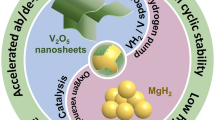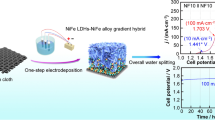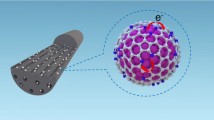Abstract
Development of high-performance catalysts with facile, self-supporting, simple and noble-metal-free features for hydrogen and oxygen evolution reactions (HER and OER) is a long-lasting pursuit. Herein, a facile self-oxidized Ni nano-foam with self-supporting nanoporosity is obtained by single-step dealloying of Mg80Ni20 metallic glass ribbons. The Ni nano-foam exhibits superior HER performance with an overpotential of 33.1 and 71.4 mV at the current density of 10 and 100 mA cm−2, and low OER overpotential of 330 mV at 10 mA cm−2. Outstanding long-term stability up to 100 h is confirmed for both HER and OER. A water electrolyzer based on the Ni nano-foam couple shows good stability and remarkable activity for overall water splitting, which requires 1.58 V to reach 10 mA cm−2. The geometry features of the Ni nano-foam, i.e., three-dimensional structure, ultrafine size, high porosity and large surface area are highly beneficial for catalytic activity. The synergic effect of the Ni/NiO composite at the ligament skin is confirmed to decrease the free energy for hydrogen binding, facilitate the H−OH bond breaking and accelerate OH− ion formation, which significantly improves the intrinsic HER activity. The outstanding HER and OER performances of the self-oxidized Ni nano-foam validate the metal nano-foams as promising catalyst candidates, especially in view of the ultrafine nanoporous, self-supporting, composition regulation, single-step synthesis and massive fabrication features.

摘要
开发组成简单、 无贵金属、 制备简洁的自支撑析氢、 析氧催化反应(HER和OER)催化剂是电解水的关键需求之一. 本文以Mg80Ni20非晶合金薄带为前驱体, 采用一步脱合金法制备了具有自支撑结构的自氧化纳米泡沫镍, 在电流密度为10 mA cm−2时HER和OER的过电位仅分别为33.1和330 mV, 且均具有长达100 h的长期稳定性. 基于纳米泡沫镍的水电解槽达到10 mA cm−2的外加电压仅为1.58 V. 纳米泡沫镍独特的三维超细多孔结构显著促进了其表观活性, 同时其Ni/NiO复合结构显著提高了本征HER活性. 本工作验证了纳米泡沫金属是一种有潜力的高性能催化材料.
Similar content being viewed by others
References
Dresselhaus MS, Thomas IL. Alternative energy technologies. Nature, 2001, 414: 332–337
Crabtree GW, Dresselhaus MS, Buchanan MV. The hydrogen economy. Phys Today, 2004, 57: 39–44
Walter MG, Warren EL, McKone JR, et al. Solar water splitting cells. Chem Rev, 2010, 110: 6446–6473
Turner JA. Sustainable hydrogen production. Science, 2004, 305: 972–974
Chu S, Majumdar A. Opportunities and challenges for a sustainable energy future. Nature, 2012, 488: 294–303
Subbaraman R, Tripkovic D, Chang KC, et al. Trends in activity for the water electrolyser reactions on 3d M(Ni,Co,Fe,Mn) hydr(oxy)oxide catalysts. Nat Mater, 2012, 11: 550–557
Han L, Dong S, Wang E. Transition-metal (Co, Ni, and Fe)-based electrocatalysts for the water oxidation reaction. Adv Mater, 2016, 28: 9266–9291
Zuo L, Li R, Jin Y, et al. Fabrication of three-dimensional nanoporous nickel by dealloying Mg−Ni−Y metallic glasses in citric acid solutions for high-performance energy storage. J Electrochem Soc, 2017, 164: A348–A354
Ali-Löytty H, Louie MW, Singh MR, et al. Ambient-pressure XPS study of a Ni−Fe electrocatalyst for the oxygen evolution reaction. J Phys Chem C, 2016, 120: 2247–2253
Kim JH, Youn DH, Kawashima K, et al. An active nanoporous Ni(Fe) OER electrocatalyst via selective dissolution of Cd in alkaline media. Appl Catal B-Environ, 2018, 225: 1–7
Hu J, Zhu S, Liang Y, et al. Self-supported Ni3Se2@NiFe layered double hydroxide bifunctional electrocatalyst for overall water splitting. J Colloid Interface Sci, 2021, 587: 79–89
McCrory CCL, Jung S, Peters JC, et al. Benchmarking heterogeneous electrocatalysts for the oxygen evolution reaction. J Am Chem Soc, 2013, 135: 16977–16987
Louie MW, Bell AT. An investigation of thin-film Ni−Fe oxide catalysts for the electrochemical evolution of oxygen. J Am Chem Soc, 2013, 135: 12329–12337
Zhao W, Xu H, Luan H, et al. NiFe layered double hydroxides grown on a corrosion-cell cathode for oxygen evolution electrocatalysis. Adv Energy Mater, 2021, 12: 2102372
Pang C, Zhu S, Xu W, et al. Self-standing Mo−NiO/Ni electrocatalyst with nanoporous structure for hydrogen evolution reaction. Electrochim Acta, 2023, 439: 141621
Jaramillo TF, Jørgensen KP, Bonde J, et al. Identification of active edge sites for electrochemical H2 evolution from MoS2 nanocatalysts. Science, 2007, 317: 100–102
Wu C, Liu B, Wang J, et al. 3D structured Mo-doped Ni3S2 nanosheets as efficient dual-electrocatalyst for overall water splitting. Appl Surf Sci, 2018, 441: 1024–1033
Lian J, Wu Y, Zhang H, et al. One-step synthesis of amorphous Ni−Fe−P alloy as bifunctional electrocatalyst for overall water splitting in alkaline medium. Int J Hydrogen Energy, 2018, 43: 12929–12938
Xiao P, Sk MA, Thia L, et al. Molybdenum phosphide as an efficient electrocatalyst for the hydrogen evolution reaction. Energy Environ Sci, 2014, 7: 2624–2629
Suntivich J, May KJ, Gasteiger HA, et al. A perovskite oxide optimized for oxygen evolution catalysis from molecular orbital principles. Science, 2011, 334: 1383–1385
Zhu Y, Zhong X, Jin S, et al. Oxygen defect engineering in double perovskite oxides for effective water oxidation. J Mater Chem A, 2020, 8: 10957–10965
Chen G, Ma TY, Liu Z, et al. Efficient and stable bifunctional electrocatalysts Ni/NixMy, (M = P, S) for overall water splitting. Adv Funct Mater, 2016, 26: 3314–3323
Liu W, Hu E, Jiang H, et al. A highly active and stable hydrogen evolution catalyst based on pyrite-structured cobalt phosphosulfide. Nat Commun, 2016, 7: 10771
Schlicht S, Büttner P, Bachmann J. Highly active Ir/TiO2 electrodes for the oxygen evolution reaction using atomic layer deposition on ordered porous substrates. ACS Appl Energy Mater, 2019, 2: 2344–2349
Yang X, Xu W, Cao S, et al. An amorphous nanoporous PdCuNi−S hybrid electrocatalyst for highly efficient hydrogen production. Appl Catal B-Environ, 2019, 246: 156–165
Liu Z, Zha M, Wang Q, et al. Overall water-splitting reaction efficiently catalyzed by a novel bi-functional Ru/Ni3N-Ni electrode. Chem Commun, 2020, 56: 2352–2355
Jiang W, Borduin R, Xin H, et al. Modeling of an electropolishing-assisted electroless deposition process for microcellular metal foam fabrication. J Manufacturing Sci Eng, 2017, 139: 031018
Huang XH, Tu JP, Xia XH, et al. Nickel foam-supported porous NiO/ polyaniline film as anode for lithium ion batteries. Electrochem Commun, 2008, 10: 1288–1290
Yamamura Y, Tawara H. Energy dependence of ion-induced sputtering yields from monatomic solids at normal incidence. Atomic Data Nucl Data Tables, 1996, 62: 149–253
Xu H, Zhang T. Formation of ultrafine spongy nanoporous metals (Ni, Cu, Pd, Ag and Au) by dealloying metallic glasses in acids with capping effect. Corrosion Sci, 2019, 153: 1–11
Xu H, Pang S, Jin Y, et al. General synthesis of sponge-like ultrafine nanoporous metals by dealloying in citric acid. Nano Res, 2016, 9: 2467–2477
Pang Y, Xu W, Zhu S, et al. Self-supporting amorphous nanoporous NiFeCoP electrocatalyst for efficient overall water splitting. J Mater Sci Tech, 2021, 82: 96–104
Jin Y, Li R, Zhang T. Formation of nanoporous silver by dealloying Ca−Ag metallic glasses in water. Intermetallics, 2015, 67: 166–170
Liu N, Li J, Ma W, et al. Ultrathin and lightweight 3D free-standing Ni@NiO nanowire membrane electrode for a supercapacitor with excellent capacitance retention at high rates. ACS Appl Mater Interfaces, 2014, 6: 13627–13634
Peng L, Liang Y, Wu S, et al. Nanoporous Ni/NiO catalyst for efficient hydrogen evolution reaction prepared by partial electro-oxidation after dealloying. J Alloys Compd, 2022, 911: 165061
Nesbitt HW, Legrand D, Bancroft GM. Interpretation of Ni2P XPS spectra of Ni conductors and Ni insulators. Phys Chem Miner, 2000, 27: 357–366
Macdonald TJ, Mange YJ, Dewi MR, et al. CuInS2/ZnS nanocrystals as sensitisers for NiO photocathodes. J Mater Chem A, 2015, 3: 13324–13331
Su F, Lv X, Miao M. High-performance two-ply yarn supercapacitors based on carbon nanotube yarns dotted with Co3O4 and NiO nanoparticles. Small, 2015, 11: 854–861
Liang Y, Sherwood PMA, Paul DK. Valence and core photoemission of the films formed electrochemically on nickel in sulfuric acid. Faraday Trans, 1994, 90: 1271–1278
Khairallah F, Glisenti A. XPS study of MgO nanopowders obtained by different preparation procedures. Surf Sci Spectra, 2006, 13: 58–71
Peck MA, Langell MA. Comparison of nanoscaled and bulk NiO structural and environmental characteristics by XRD, XAFS, and XPS. Chem Mater, 2012, 24: 4483–4490
Skúlason E, Tripkovic V, Björketun ME, et al. Modeling the electrochemical hydrogen oxidation and evolution reactions on the basis of density functional theory calculations. J Phys Chem C, 2010, 114: 18182–18197
Gong M, Zhou W, Tsai MC, et al. Nanoscale nickel oxide/nickel heterostructures for active hydrogen evolution electrocatalysis. Nat Commun, 2014, 5: 4695
Kou T, Smart T, Yao B, et al. Theoretical and experimental insight into the effect of nitrogen doping on hydrogen evolution activity of Ni3S2 in alkaline medium. Adv Energy Mater, 2018, 8: 1703538
Liu T, Feng B, Wu X, et al. Ru2P nanoparticle decorated P/N-doped carbon nanofibers on carbon cloth as a robust hierarchical electrocatalyst with platinum-comparable activity toward hydrogen evolution. ACS Appl Energy Mater, 2018, 1: 3143–3150
Zhang H, Liu Y, Wu H, et al. Open hollow Co−Pt clusters embedded in carbon nanoflake arrays for highly efficient alkaline water splitting. J Mater Chem A, 2018, 6: 20214–20223
Haque F, Zavabeti A, Zhang BY, et al. Ordered intracrystalline pores in planar molybdenum oxide for enhanced alkaline hydrogen evolution. J Mater Chem A, 2019, 7: 257–268
Li N, Zhang Y, Jia M, et al. 1T/2H MoSe2-on-MXene heterostructure as bifunctional electrocatalyst for efficient overall water splitting. Electrochim Acta, 2019, 326: 134976
Fu L, Li Y, Yao N, et al. IrMo nanocatalysts for efficient alkaline hydrogen electrocatalysis. ACS Catal, 2020, 10: 7322–7327
Wang Z, Xiao B, Lin Z, et al. PtSe2/Pt heterointerface with reduced coordination for boosted hydrogen evolution reaction. Angew Chem Int Ed, 2021, 60: 23388–23393
Wu L, Yu L, Zhang F, et al. Heterogeneous bimetallic phosphide Ni2P−Fe2P as an efficient bifunctional catalyst for water/seawater splitting. Adv Funct Mater, 2020, 31: 2006484
Dong T, Zhang X, Cao Y, et al. Ni/Ni3C core-shell nanoparticles encapsulated in N-doped bamboo-like carbon nanotubes towards efficient overall water splitting. Inorg Chem Front, 2019, 6: 1073–1080
Barati Darband G, Aliofkhazraei M, Hyun S, et al. Electrodeposition of Ni−Co−Fe mixed sulfide ultrathin nanosheets on Ni nanocones: A low-cost, durable and high performance catalyst for electrochemical water splitting. Nanoscale, 2019, 11: 16621–16634
Saraj CS, Singh SC, Shukla A, et al. Single-step and sustainable fabrication of Ni(OH)2/Ni foam water splitting catalysts via electric field assisted pulsed laser ablation in liquid. ChemElectroChem, 2021, 8: 209–217
Zhao L, Zhang Y, Zhao Z, et al. Steering elementary steps towards efficient alkaline hydrogen evolution via size-dependent Ni/NiO nanoscale heterosurfaces. Natl Sci Rev, 2020, 7: 27–36
Yao M, Wang B, Sun B, et al. Rational design of self-supported Cu@WC core-shell mesoporous nanowires for pH-universal hydrogen evolution reaction. Appl Catal B-Environ, 2021, 280: 119451
Tian R, Zhao S, Li J, et al. Pressure-promoted highly-ordered Fe-doped-Ni2B for effective oxygen evolution reaction and overall water splitting. J Mater Chem A, 2021, 9: 6469–6475
Jović BM, Lačnjevac UČ, Jović VD, et al. Kinetics of the oxygen evolution reaction on NiSn electrodes in alkaline solutions. J Electroanal Chem, 2015, 754: 100–108
Hu F, Zhu S, Chen S, et al. Amorphous metallic NiFeP: A conductive bulk material achieving high activity for oxygen evolution reaction in both alkaline and acidic media. Adv Mater, 2017, 29: 1606570
Brug GJ, van den Eeden ALG, Sluyters-Rehbach M, et al. The analysis of electrode impedances complicated by the presence of a constant phase element. J Electroanal Chem Interfacial Electrochem, 1984, 176: 275–295
Jiang M, Li Y, Lu Z, et al. Binary nickel-iron nitride nanoarrays as bifunctional electrocatalysts for overall water splitting. Inorg Chem Front, 2016, 3: 630–634
Wang X, Li W, Xiong D, et al. Bifunctional nickel phosphide nano-catalysts supported on carbon fiber paper for highly efficient and stable overall water splitting. Adv Funct Mater, 2016, 26: 4067–4077
Li C, Hou J, Wu Z, et al. Acid promoted Ni/NiO monolithic electrode for overall water splitting in alkaline medium. Sci China Mater, 2017, 60: 918–928
Chen Q, Wang R, Yu M, et al. Bifunctional iron-nickel nitride nanoparticles as flexible and robust electrode for overall water splitting. Electrochim Acta, 2017, 247: 666–673
Yu J, Cheng G, Luo W. Ternary nickel-iron sulfide microflowers as a robust electrocatalyst for bifunctional water splitting. J Mater Chem A, 2017, 5: 15838–15844
Lin G, Wang Y, Hong J, et al. Nanoheterostructures of partially oxidized RuNi alloy as bifunctional electrocatalysts for overall water splitting. ChemSusChem, 2020, 13: 2739–2744
Chen W, Zhang Y, Chen G, et al. Hierarchical porous bimetal-sulfide bi-functional nanocatalysts for hydrogen production by overall water electrolysis. J Colloid Interface Sci, 2020, 560: 426–435
Luo X, Li R, Huang L, et al. Nucleation and growth of nanoporous copper ligaments during electrochemical dealloying of Mg-based metallic glasses. Corrosion Sci, 2013, 67: 100–108
Liu H, Cao G. Effectiveness of the Young-Laplace equation at nanoscale. Sci Rep, 2016, 6: 23936
Zhong Y, Markmann J, Jin HJ, et al. Crack mitigation during dealloying of Au25Cu75. Adv Eng Mater, 2014, 16: 389–398
Xu H, Pang S, Zhang T. Self-oxidized sponge-like nanoporous nickel alloy in three-dimensions with pseudocapacitive behavior and excellent capacitive performance. J Power Sources, 2018, 399: 192–198
Nørskov JK, Bligaard T, Logadottir A, et al. Trends in the exchange current for hydrogen evolution. J Electrochem Soc, 2005, 152: J23
Pan X, Zhou G. A theoretical study on the mechanism of hydrogen evolution on non-precious partially oxidized nickel-based heterostructures for fuel cells. Phys Chem Chem Phys, 2018, 20: 7968–7973
Acknowledgements
This work was supported by the National Natural Science Foundation of China (52271148, 51971006 and 51971092) and the Fundamental Research Funds for the Central Universities (2023MS092).
Author information
Authors and Affiliations
Contributions
Author contributions Xu H conceived the study and carried out methodology, investigation, visualization and draft-writing with the aid of Zhao W, Guo R, Xue Z and Shao Y. Wang X performed the DFT study with the resources and foundation supplied by Zhang T. Yao K supervised the entire study and offered the main foundation. All authors contributed to the general discussion.
Corresponding authors
Ethics declarations
Conflict of interest The authors declare that they have no conflict of interest.
Additional information
Hongjie Xu received his PhD degree in materials science and engineering from Beihang University in 2019. He was a postdoc at Tsinghua University from 2019 to 2022. Since 2023, he has been an assistant professor at the Institute for Advanced Materials, North China Electric Power University. His current research interests are focused on the design and application of metallic glasses and nanoporous metals.
Kefu Yao received his PhD degree from Tsinghua University in 1989. He worked as a postdoc at the University of Science and Technology Beijing from 1989 to 1992, and at Kyoto University as a JSPS fellow from 1992 to 1995. Then, he joined Tsinghua University as a professor. He is mainly engaged in the fabrication and application of advanced metal materials such as amorphous alloy, high-entropy alloy and nanocrystalline alloy.
Supplementary information Supporting data are available in the online version of the paper.
Supplementary Information
Rights and permissions
About this article
Cite this article
Xu, H., Wang, X., Zhao, W. et al. Facile self-oxidized Ni nano-foam as high-performance catalyst for hydrogen and oxygen evolution. Sci. China Mater. 66, 3855–3864 (2023). https://doi.org/10.1007/s40843-023-2522-y
Received:
Accepted:
Published:
Issue Date:
DOI: https://doi.org/10.1007/s40843-023-2522-y




